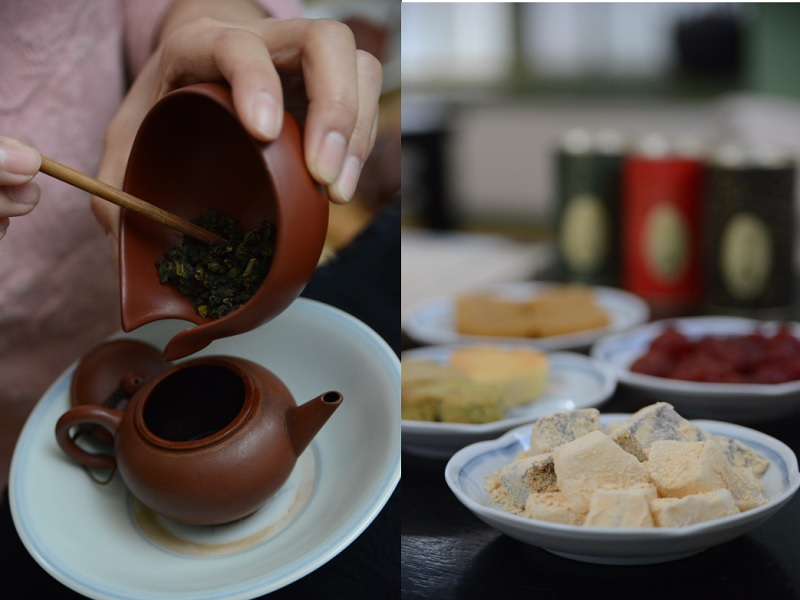Wistaria Tea House
by Qian Leung
@ 28 Jul 2017

Wistaria Tea House was built in 1920, when Taiwan was under Japanese rule, as a residence for marines. After the Japanese left, it became home to economist Chou Te Wei, and a meeting place for intellectuals in the 1950s. Together, they founded a publication that questioned the political suppression by Kuomintang on dissenting voices, and sought the protection of human rights and freedoms. In the 1970s, the home was left in the care of Chou’s youngest son, Yu, a tea connoisseur. When the Kaohsiung Incident happened (a pro-democracy magazine’s founders were arrested by Kuomintang), academics and activists began to meet in Chou Yu’s home, strategising for liberty. In 1981, Yu turned his home into a tea house. Straw yellow in colour, lan ruo, which means ‘orchid-like’, has the perfumy scent of lily-of-the-valley, freesia, and jasmine. Li shan (pear mountain), with a honey colour, has the scent of roasted malt. Zi teng (wistaria), consisting of dong ding oolong (frosted peak black dragon), has the scent of dried mandarin peels and cinnamon bark. “Its bitterness disappears quickly, leaving a faint sweetness,” says Wang Ying Fang, 35, our tea brewer. “Compared to lan ruo, which is a like a young maiden, dong ding oolong is like a mature gentleman.” Zi yuan (fate), which features tie guan yin (iron goddess of mercy), has the colour of rust and the scent of osmanthus, copper, and smoke. Xun (tipsy), made with dong fang mei ren (oriental beauty), offers the scent of orange honey, tuberose, and incense.
 Wistaria Tea House was built in 1920, when Taiwan was under Japanese rule, as a residence for marines. After the Japanese left, it became home to economist Chou Te Wei, and a meeting place for intellectuals in the 1950s. Together, they founded a publication that questioned the political suppression by Kuomintang on dissenting voices, and sought the protection of human rights and freedoms. In the 1970s, the home was left in the care of Chou’s youngest son, Yu, a tea connoisseur. When the Kaohsiung Incident happened (a pro-democracy magazine’s founders were arrested by Kuomintang), academics and activists began to meet in Chou Yu’s home, strategising for liberty. In 1981, Yu turned his home into a tea house. Straw yellow in colour, lan ruo, which means ‘orchid-like’, has the perfumy scent of lily-of-the-valley, freesia, and jasmine. Li shan (pear mountain), with a honey colour, has the scent of roasted malt. Zi teng (wistaria), consisting of dong ding oolong (frosted peak black dragon), has the scent of dried mandarin peels and cinnamon bark. “Its bitterness disappears quickly, leaving a faint sweetness,” says Wang Ying Fang, 35, our tea brewer. “Compared to lan ruo, which is a like a young maiden, dong ding oolong is like a mature gentleman.” Zi yuan (fate), which features tie guan yin (iron goddess of mercy), has the colour of rust and the scent of osmanthus, copper, and smoke. Xun (tipsy), made with dong fang mei ren (oriental beauty), offers the scent of orange honey, tuberose, and incense.
Wistaria Tea House was built in 1920, when Taiwan was under Japanese rule, as a residence for marines. After the Japanese left, it became home to economist Chou Te Wei, and a meeting place for intellectuals in the 1950s. Together, they founded a publication that questioned the political suppression by Kuomintang on dissenting voices, and sought the protection of human rights and freedoms. In the 1970s, the home was left in the care of Chou’s youngest son, Yu, a tea connoisseur. When the Kaohsiung Incident happened (a pro-democracy magazine’s founders were arrested by Kuomintang), academics and activists began to meet in Chou Yu’s home, strategising for liberty. In 1981, Yu turned his home into a tea house. Straw yellow in colour, lan ruo, which means ‘orchid-like’, has the perfumy scent of lily-of-the-valley, freesia, and jasmine. Li shan (pear mountain), with a honey colour, has the scent of roasted malt. Zi teng (wistaria), consisting of dong ding oolong (frosted peak black dragon), has the scent of dried mandarin peels and cinnamon bark. “Its bitterness disappears quickly, leaving a faint sweetness,” says Wang Ying Fang, 35, our tea brewer. “Compared to lan ruo, which is a like a young maiden, dong ding oolong is like a mature gentleman.” Zi yuan (fate), which features tie guan yin (iron goddess of mercy), has the colour of rust and the scent of osmanthus, copper, and smoke. Xun (tipsy), made with dong fang mei ren (oriental beauty), offers the scent of orange honey, tuberose, and incense.